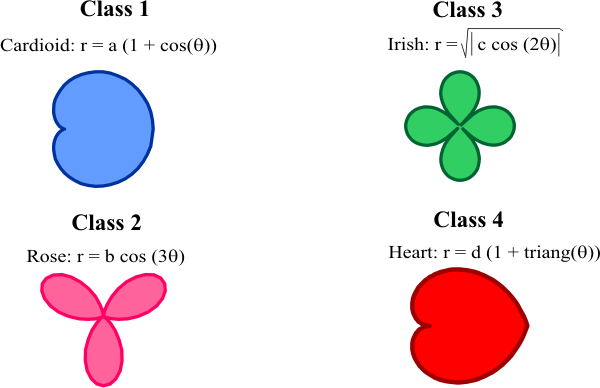| Problem 1 |
| Build an appropriate training set for the classification of the four shapes in the time domain and in the frequency domain (using the Fourier Transform). Your training set will include clean and noisy shapes as described below using a random phase to build each case. The table indicates the number of training cases for each shape. |
| Shape | Clean | 10% Noise | 20% Noise | 30% Noise |
| Cardioid | 250 | 250 | 250 | 250 |
| Rose | 150 | 150 | 150 | 150 |
| Irish | 200 | 200 | 200 | 200 |
| Heart | 150 | 150 | 150 | 150 |

| Hint |
| To keep your files organized use the file names as described in the table below. |
| Test | Time Domain | Frequency Domain |
| Build Train Set | BuidTrainSetT.lab | BuildTrainSetF.lab |
| Training Set | TrainSetT.csv | TrainSetF.csv |
| Build Validation Set | BuidValidSetT.csv | BuildValidSetF.csv |
| Validation Set | ValidSetT.csv | ValidSetF.csv |
| Training | TrainT.lab | TrainF.lab |
| Check Training | CheckTrainingT.lab | CheckTrainingF.lab |
| (Trainining) Confusion Matrix | trainConfT.emf | trainConfF.emf |
| Validation | ValidationT.lab | ValidationF.lab |
| (Validation) Confusion Matrix | validConfT.emf | validConfF.emf |
| Problem 2 |
| Build an appropriate validation set for problem 1 using random phase. The table below describes the number of validation cases for each shape. |
| Shape | Clean | 10% Noise | 20% Noise | 30% Noise |
| Cardioid | 100 | 100 | 100 | 100 |
| Rose | 50 | 50 | 50 | 50 |
| Irish | 40 | 40 | 40 | 40 |
| Heart | 90 | 90 | 90 | 90 |
| Problem 3 |
| Design and train an ANN for the classification of the shapes. |
| Problem 4 |
| Check the training: (a) Compute the confusion matrix using the training set. (b) Save the confusion matrix as vector image. |
| Problem 5 |
| Perform the validation of the ANN. (a) Compute the confusion matrix using the validation set. (b) Save the confusion matrix as vector image. |
| Problem 6 |
| Generate a report in Microsoft Word. Write some conclusions in the report trying to compare your results using data in the time domain with the data in the frequency domain. |